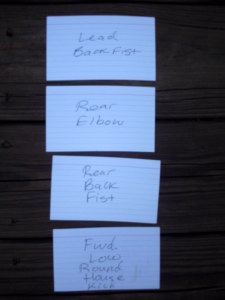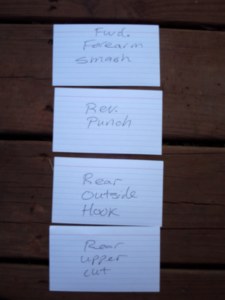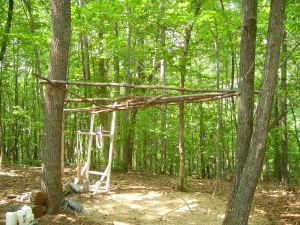Part 2 of 6. Footnotes, references, and demonstration video clips will be posted in the last entry.
A Tale of Two Miyagis
Despite the general scarcity of information in historical writings, there are at least two modern sources (available in English) that reference the ude makiwara and provide diagrams. The first, Traditional Karatedo Okinawa Goju Ryu Vol. 1 by Morio Higaonna, contains illustrations of several different types of makiwara, all of which are less common variations on the theme.
The round design pictured is comprised of a post of unspecified dimensions, with two intersecting cuts made into it lengthwise from the top. These cuts create four sections that serve as striking surfaces in lieu of a single tapered board. Rope is shown wrapped around the upper portion as a striking surface. The result is a makiwara that can be hit from all sides with presumably equal amounts of give.
No instructions for construction or usage accompany the diagram. Nor can any specific conclusions about its history be assumed. However, Higaonna trained under Miyagi An’ichi, a top student of Goju-Ryu founder Miyagi Chojun. According to a recent interview, An’ichi was Morio Higaonna’s sole teacher, and An’ichi himself had been Miyagi Chojun’s only student at times.7
Miyagi’s teacher, Higaonna Kanyro, studied various boxing systems in China as a young man, which presents the possibility that the ude makiwara was brought back to Okinawa by him. He may also have encountered the basic round striking post in China and later created the version pictured in Traditional Karatedo. If either is the case, then the ude makiwara design shown is an artifact of Naha karate training as taught and propagated by Higaonna, and later Miyagi et al, although the possibility that the design came from another source certainly does exist.
Notes From Matsumura Shorin Ryu
Another variation on the ude design appears in Bishop’s Okinawan Karate.8 This information comes from an interview with Seiki Arakaki, a late student of the late Hohan Soken, who trained in the Matsumura Orthodox lineage. When discussing makiwara training, Arakaki states:
“There were, and still are, basically two types of makiwara, the flat board and the round post. The flat one is used for practicing the straight corkscrew punch and the round one, which has one or two splits to halfway down the middle, is used for training the fist, elbow and the side of the hand.”
As for the makiwara itself, a clear drawing with measurements for the height of the post is included but no information for the diameter. The diagram indicates a 200cm long post that has been cut lengthwise four times as opposed to twice, resulting in eight flexible sections instead of four. The top of the post is also shown wrapped with rice straw rope.
As a royal bodyguard and officer at the end of the second Sho dynasty, Matsumura Sokon himself would have been privy to knowledge gained from exchange trips to China and resident Chinese envoys. According to Kerr’s work Okinawa: The History of an Island People, in the days of the second Sho dynasty “residence at Tomari suggested scholarship and association with the Chinese living there.” Given his access to these resources, it would not be difficult to imagine that Matsumura introduced the ude makiwara from a Chinese source into the larger community.
But cultural diffusion seldom takes one path- Kerr continues, “The Naha man was presumed to be less conservative, to be more knowledgeable in the latest songs and dances, the newest patterns and styles of dress, the latest slang.” And the Naha community was likely exposed to a wide spectrum of fighting- the ports there were backdrop to a shifting mixture of sailors from China, Japan, Korea, Siam, Java, the Pacific islands and continental Southeast Asia. The ude makiwara may have been an intentional import form China, or an incidental one from exchanges at the ports.
Back to Goju?
Its tempting to attempt to trace this makiwara back to Matsumura’s days (via Hohan Soken), but Arakaki had more than one teacher. As well as training with Hohan Soken in Matsumura Orthodox Shorin Ryu from the 1950’s on, Arakaki had also trained in Goju-Ryu under Seiko Higa, who in turn was a student of Kanryo Higaonna (and later, Miyagi Chojun). Arakaki’s Goju background brings into play the possibility that the ude makiwara shown is a product of his Goju Ryu exposure, along the same lines discussed earlier.
Arakaki might well have come by this makiwara via his training under either teacher and lineage- but it may be that he knew it from an unrelated source, or that it was simply common knowledge via one or both routes of cultural exchange with China. If that is the case, the ude makiwara shown should have equivalent cousins in Chinese boxing systems that may well still be in use, or referenced in older reference publications and manuals. While it does not provide us with a definitive history, this information does suggest that either or both the Matsumura Shorin Ryu and Naha (Goju/To’on) traditions practiced (and practice still) with this design, and that it may have come to Okinawa as a result of inentional or informal exchange with Chinese martial artists.9
Without notes on the specific origins of any of the three versions (a tapered pole, a post with two splits, a post with four splits), its difficult to place these designs in context with karate’s historical timeline, or to compare the different methods of using them. However, given the reference in Motobu’s book, inclusion in Morio Higaonna’s work and the dual possible origins presented in Bishop’s (via Arakaki), it is safe to assume that the ude makiwara was at one point a relatively common piece of equipment in the generalized Shuri, Naha and Tomari karate circles that has been overshadowed in propagation and modern use by its flatter relative.















 are available here.
are available here.